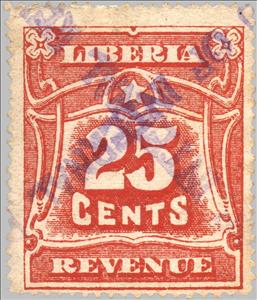Stamp: Numeral (Liberia 1914)
Numeral (Liberia 1914)
01 January (Liberia ) within release Revenue goes into circulation Stamp Numeral face value 25 Liberian cent
| Stamp Numeral in catalogues | |
|---|---|
| Colnect codes: | Col: LR R1914-17 |
Stamp is square format.
Stamp of 1911 overprinted "BUREAU OF INTERNAL REVENUE" with a diagonal rubber handstamp in violet, violet-black or black The handstamp is 61mm long, such that only parts of it are visible on individual stamps. It may exist reading upwards or downwards, upright or inverted.Also in the issue Revenue:
- Stamp - African Elephant (Loxodonta africana) face value 1;
- Stamp - Coffee plantation (Coffea arabica) face value 1;
- Stamp - Coffee plantation (Coffea arabica) face value 1;
- Stamp - Numeral face value 5;
- Stamp - Numeral face value 10;
- Stamp - Numeral face value 15;
- Stamp - Numeral face value 20;
- Stamp - Numeral face value 25;
- Stamp - Numeral face value 30;
- Stamp - Numeral face value 50;
- Stamp - Numeral face value 1;
- Stamp - Numeral face value 2;
- Stamp - Numeral face value 5;
- Stamp - Numeral face value 5;
- Stamp - Numeral face value 10;
- Stamp - Numeral face value 15;
- Stamp - Numeral face value 20;
- Stamp - Numeral face value 25;
- Stamp - Numeral face value 30;
- Stamp - Numeral face value 50;
- Stamp - Numeral face value 5;
- Stamp - President Arthur Barclay (1854-1938) face value 2;
|
Data entry completed
56%
|
|
|---|---|
| Stamp Numeral in digits | |
| Country: | Liberia |
| Date: | 1914-01-01 |
| Paper: | thin, soft, whitish |
| Perforation: | 14 |
| Emission: | Revenue |
| Format: | Stamp |
| Face Value: | 25 Liberian cent |
Stamp Numeral it reflects the thematic directions:
A number is a mathematical object used to count, measure, and label. The most basic examples are the natural numbers 1, 2, 3, 4, and so forth. Numbers can be represented in language with number words. More universally, individual numbers can be represented by symbols, called numerals; for example, "5" is a numeral that represents the number five. As only a relatively small number of symbols can be memorized, basic numerals are commonly organized in a numeral system, which is an organized way to represent any number. The most common numeral system is the Hindu–Arabic numeral system, which allows for the representation of any non-negative integer using a combination of ten fundamental numeric symbols, called digits. In addition to their use in counting and measuring, numerals are often used for labels (as with telephone numbers), for ordering (as with serial numbers), and for codes (as with ISBNs). In common usage, a numeral is not clearly distinguished from the number that it represents.
A star is a luminous spheroid of plasma held together by self-gravity. The nearest star to Earth is the Sun. Many other stars are visible to the naked eye at night; their immense distances from Earth make them appear as fixed points of light. The most prominent stars have been categorised into constellations and asterisms, and many of the brightest stars have proper names. Astronomers have assembled star catalogues that identify the known stars and provide standardized stellar designations. The observable universe contains an estimated 1022 to 1024 stars. Only about 4,000 of these stars are visible to the naked eye—all within the Milky Way galaxy.


